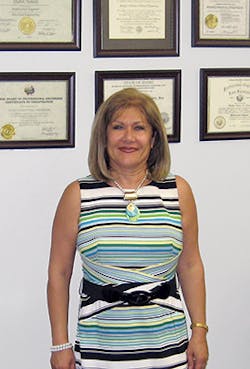At M.E.P. Consulting Engineers (MEPCE) in the Dallas/Fort Worth area, “all of our projects are designed with energy conservation and sustainability in mind,” says Sheila Nemati, company president. Nemati is a registered professional engineer in Texas and in many other states. “We have designed many LEED (Leadership in Energy & Environmental Design)-certified facilities, some of which are Gold or Silver Certified. Our LEED designs consist of solar and wind renewable power, geothermal energy for heating and cooling, use of energy-efficient equipment and energy-efficient lighting, energy savings controls, and water conservation measures. We also pay attention to indoor air quality and the comfort factor of the end users in order to design a project that can set examples for others to follow.”
MEPCE endeavors to employ the process of sustainability in every aspect of the project, thereby exceeding what can be considered typical engineering design strategies. With Nemati at the helm, MEPCE has engineered numerous green buildings in its ongoing mission to research and implement green approaches, methods, and technologies.
What She Does Day to Day
Nemati’s job duties are divided into two different categories. One is business development in which she looks for new business opportunities and maintains client relations. “Our clients include aviation, transportation, healthcare, municipal, education, federal, commercial, and industrial-type clients,” says Nemati.
The second is the technical category in which her duties are to perform quality control and quality assurance on all of the engineering projects that go out of her office. “This includes verification of all the engineering calculations; verification of compliance with all applicable codes; coordination between in-house mechanical, electrical, plumbing, and information technology engineers; and coordination among the in-house engineers and other consultants such as architects, civil, and structural engineers,” says Nemati.
What Led Her Into This Line of Work
As a young teenager, Nemati had always been fascinated with mathematics and performed strong in the subject. “I went above and beyond my school work in this subject and would find complex math problems to solve from textbooks ahead of my grade,” she says. “My interest in math led me to be interested in science and engineering where I completed my bachelor’s degree in electrical engineering from the University of Missouri, Columbia. My passion for the environment and energy conservation led me into the field for design of energy-efficient buildings.”
What She Likes Best About Her Work
“In my work, I constantly face different challenges for each project,” says Nemati. “Overcoming these challenges and the satisfaction when each project is completed and constructed is rewarding for me. In addition, researching new technologies helps me remain focused on looking for new opportunities of energy savings for our projects.”
Her Biggest Challenge
“I find that oftentimes, clients are misinformed about the advantages or disadvantages of different energy-savings strategies,” points out Nemati. “Manufacturers do a great job of leading end users to believe their system is the best, most energy-efficient one with a great return on investment. Unfortunately, that’s only true under the right set of circumstances, which sometimes may or may not apply to our clients.”
Nemati says she must understand the short- and long-term goals, operating procedures, budget, and unique conditions that apply to each project. “By deeply engaging with the client and end users, modeling different scenarios and conducting models and studies, I’m able to inform the client of their options and costs as well as advantages and disadvantages,” she says. “This is challenging, but it allows me to provide my clients with unique solutions that fit their unique needs.”


